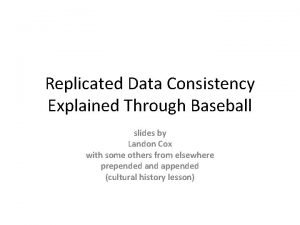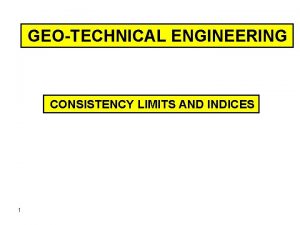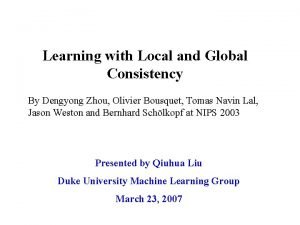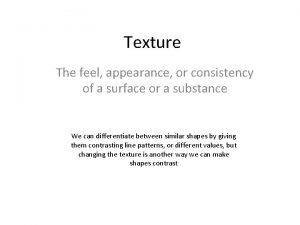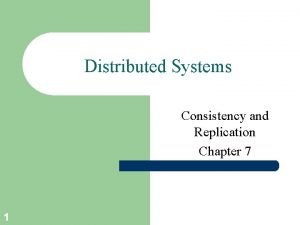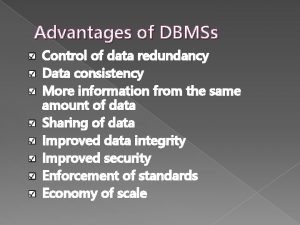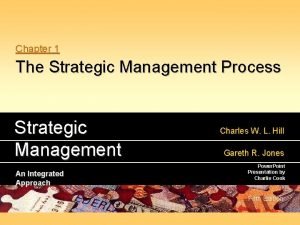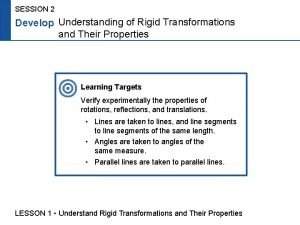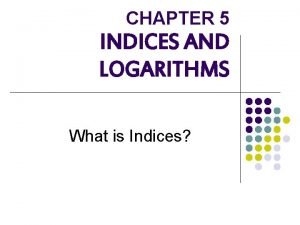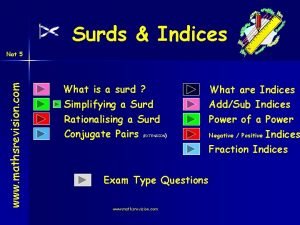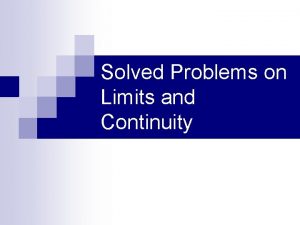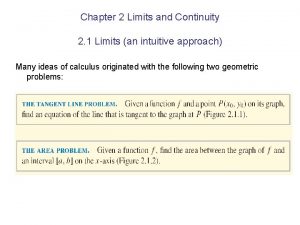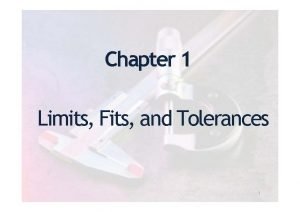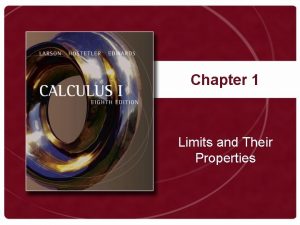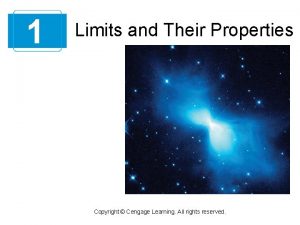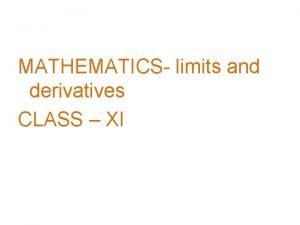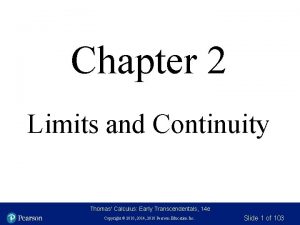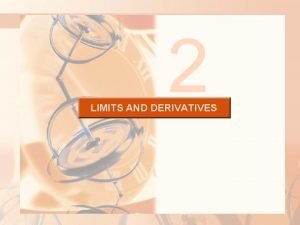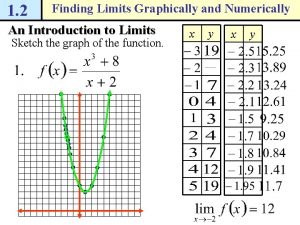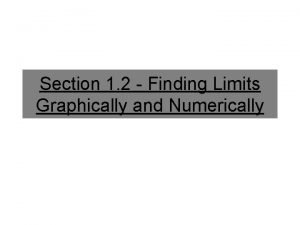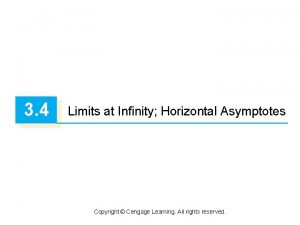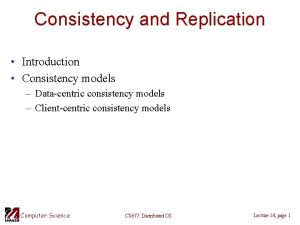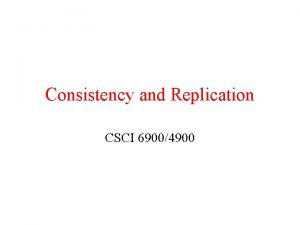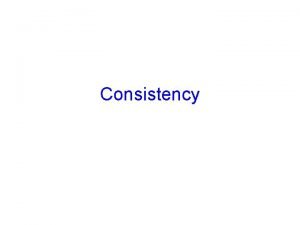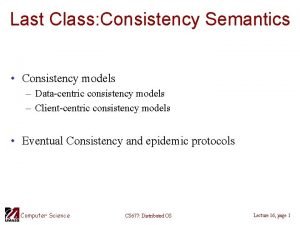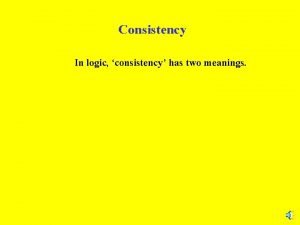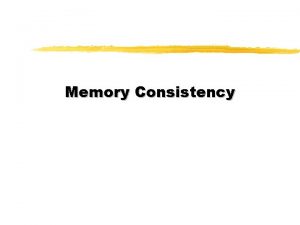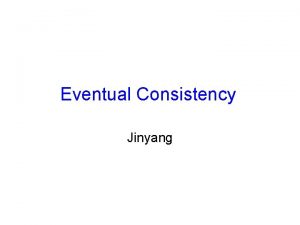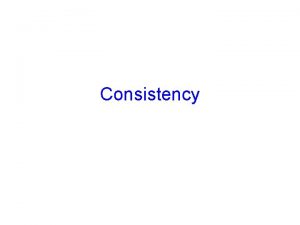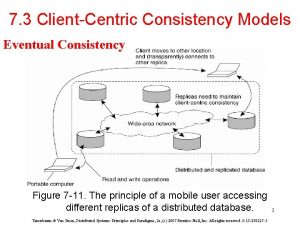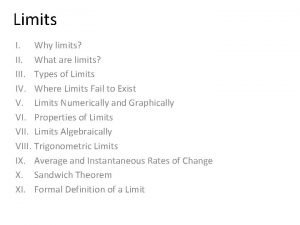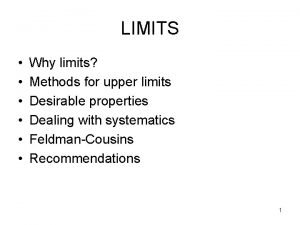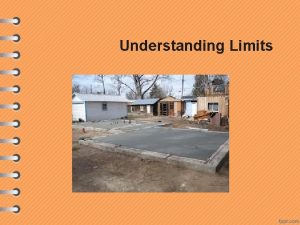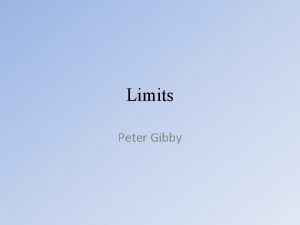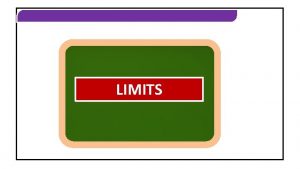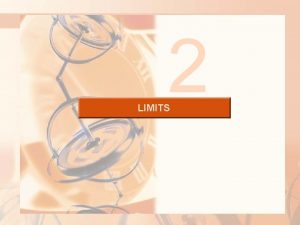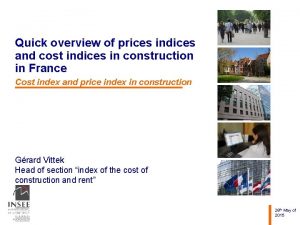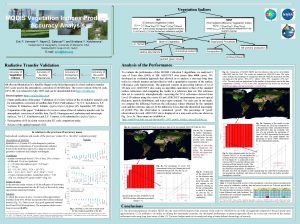6 CONSISTENCY LIMITS AND INDICES 1 This figure


































- Slides: 34

6. CONSISTENCY LIMITS AND INDICES 1

This figure shows how the nature of soil behavior is divided into four states based on the value of the moisture content. 2

3

General § The consistency of clays and other cohesive soils (fine-grained soils) is greatly influenced by the water content of the soil. § Depending on the moisture content, the behavior of soil can be divided into four basic states: • Solid • Semisolid • Plastic • Liquid § The water content at which a soil passes from one state to another is different for different soils and can be used in a qualitative way, to distinguish between, or classify different fine-grained soil types. 4

In Summary 1. Water influences consistency of fine-grained soils. 2. Soils passes from one state to another state as water content changes. 3. Different soils passes from state to state at different water contents. 4. The water content at which different soils pass from one state to another state can be used to classify or distinguish different fine-grained soils. 5. How we can find the water content at which a given soil passes from a given state to another? . Atterberg (A Swedish scientist) developed a method to describe the consistency of fine-grained soils with varying degrees of moisture content. He defined several limits of consistency which are called Atterberg limits. 5

Atterberg Limits Border line water contents, separating the different states of a fine grained soil 0 Shrinkage limit brittl esolid 6 Plastic limit semisolid Liquid limit plasti c water content liquid

Atterberg or Consistency Limits Liquid Limit (LL): The moisture content, in percent, at the point of transition from plastic to liquid state Plastic Limit (PL): The moisture content, in percent, at the point of transition from semisolid to plastic state Shrinkage Limit (SL): The moisture content, in percent, at the point of transition from solid to semisolid state There also another two limits, but they have no significance for civil engineers: Sticky Limit: The water content at which a soil loses its ADHESION to a metal blade. Cohesion Limit: The water content at which the grains cease to cohere to each other, e. g. at which cultivation of the soil does not result in clods or lumps forming. These two limits are important for the agriculturist and to earthwork 7 contractors, and also in ceramic industry.

Importance of Atterberg limits § If we know how the water content of our sample is relative to the Atterberg limits, then we already know a great deal about the engineering response of our sample. § The Atterberg limits are water contents at certain limiting or critical stages in soil behavior. § The Atterberg limits along with the natural water content, are the most important items in the description of fine-grained soils. 8

The Atterberg limits are used for four general applications: 1. To obtain general information about a soil and its strength, compressibility, permeability, shrinkage, and swell properties. 2. Used in empirical correlations for some engineering properties. 3. For soil classification 4. In construction specifications Remark Atterberg limits are conducted on completely REMOLDED soils. They therefore do not account for the importance of the structure of the soil as related to the soil behavior. So there main usefulness is in classification of soils and only qualitatively they give some ideas about behavior.

Determination of Atterberg Limits § Atterberg’s original consistency limit tests were rather arbitrary and not easily reproducible. § A. Casagrande subsequently standardized the apparatus and the procedures to make the measurement more repeatable. 10

Liquid limit 1. Multi-Point Method (ASTM D-4318) The water content required to close a distance of ½ inch (12. 7 mm) along the bottom of the groove after 25 blows is defined as the Liquid Limit. 11

§ It is difficult to adjust the moisture content in soil to meet the required ½ inch closure of the groove at 25 blows. Hence, at least 4 tests for the same soil are made at varying w%, and then w% values are plotted against the logarithm of the number of blows, N. 12 Why Semi logarithmic plot?

13

2. One-Point Method (ASTM D-4318) § Proposed by the USACE in 1949 based on the analysis of hundreds of liquid limit tests. w. N = moisture content of the soil which closed in N blows (N should be between 10 and 40). N = number of blows required to close the standard groove for a distance of ½ inch (12. 7 mm) § This formula generally yields good results for the number of blows between 20 and 30. 14

3. Fall-Cone Method (British Standard – BS 1377) § This method is popular in Europe and Asia. § The cone is released for 5 seconds so that it may penetrate the § 15 soil. The liquid limit is defined as the water content of the soil which allows the cone to penetrate exactly 20 mm during that period of time.

16

Plastic Limit (PL) 1. Rolling into Thread Method (ASTM D-4318) The plastic limit is defined as the moisture content in percent, at which the soil crumbles, when rolled into threads of 3. 18 mm (1/8 in. ) in diameter. 17

2. Fall-Cone Method Similar to Liquid Limit test only the weight of the cone is 2. 35 N (240 grams) instead of 0. 78 N (80 grams). (three times heavier). 18

PL =37. 5% 19

Remarks § The liquid limit of a soil containing substantial amounts of organic matter decreases dramatically when the soil is ovendried before testing. Comparison of the liquid limit of a sample before and after oven-drying can therefore be used as a qualitative measure of organic matter content of a soil. § The plastic limit test is performed on material prepared for the liquid limit test. § The multipoint liquid limit method is generally more precise than the one-point method. It is recommended that the multipoint method be used in cases where test results may be subject to dispute, or where greater precision is required. § The correlation on which the calculations of the one-point method are based may not be valid for certain soils, such as organic soils or soils from a marine environment. It is strongly recommended that the liquid limit of these soils be determined by the multipoint method. 20

Shrinkage Limit (SL) (ASTM D-427, ASTM D-4943) o Soil shrinks as moisture is gradually lost from it. With continuing loss of moisture, a stage of equilibrium is reached at which more loss of moisture will result in no further volume change o The shrinkage limit is defined as the moisture content, in percent, at which the volume of the soil mass ceases to change.

INDICES OF SOIL CONSISTENCY Various indices have been developed using Atterberg limits. 1. Plasticity Index (PI) PI = LL - PL q This index provides a measure of a soil plasticity, which is the amount of water that must be added to change a soil from its plastic limit to its liquid limit. q The PI is useful in engineering classification of finegrained soils, and many engineering properties have been found to correlate with the PI. q The plasticity index, in conjunction with the mechanical analysis, provides the basis for several of the engineering classification of soils. 22

23

2. Liquidity Index (LI) q The relative consistency of a cohesive soil in the natural state can be defined by a ratio called the Liquidity Index, which is given by q This index provides a clue as the condition of the in situ soil. This index helps us to know if our sample was likely to behave as a plastic, a brittle, or a liquid. • • • 24 If LI< 0 Brittle behavior (desiccated (dried) hard soil) If 0 <LI <1 The soil behave like a plastic If LI>1 The soil is a very viscous liquid.

3. Consistency Index 4. Flow Index This index is the slope of the flow curve. A low number (flat slope) indicates that a small change in moisture content is likely to produce a significant change in the soil CONSISTENCY. 5. Toughness Index 25 TI= PI/IF

Example The following data were obtained from the liquid and plastic limit tests for a soil: Liquid limit test: w% N 42. 1 17 38. 2 22 36. 2 27 34. 1 32 Plastic limit test: PL = 21. 3% In situ moisture content=25. 7% Find: LL, PI, LI, Fi 26

6. Activity § The presence of even small amounts of certain clay minerals in a soil mass can have a significant effect on the properties of the soil. § Identifying the type and amount of clay minerals may be necessary in order to predict the soil’s behavior or to develop methods for minimizing detrimental effects. § An indirect method of obtaining information on the type and effect of clay minerals in a soil is to relate plasticity to the quantity of clay–sized particles. § It is known that for a given amount of clay mineral, the plasticity resulting in a soil will vary for the different types of clays. 27

§ The plasticity index (PI) of a soil increases linearly with the percentage of clay-size fraction (%finer than 2 micrometer by weight present). § We can see form the plot below that different clays have different correlation of PI with clay-size fraction. This is because that different clay minerals have different plasticity characteristics. 28

§ A quantity called activity is defined as the slope of the line correlating PI and %finer then 2 micrometer and expressed as: Note: The line is considered to pass through the origin. § The activity factor gives information on the type and effect of CLAY MINERAL in a soil. 29

§ Clay minerals with KAOLINITE have LOW activity, whereas those soils with MONTMORILLONITE will have a HIGH activity value. § Activity is used as an index for identifying the swelling potential of clay soils. 30 Activity Classification <0. 75 Inactive clays 0. 75 -1. 25 Normal Clays >1. 25 Active Clays

PLASTICITY CHART § Casagrande (1932) studied the relationship of the plasticity index to the liquid limit of a wide variety natural soils. § On the basis of the test results, he proposed a B-Line plasticity chart as shown below. This chart was developed by plotting the results of several hundred tests. CH CL-ML CL MH ML 31

32

§ Above A-line Clays Below A-line Silts and organic soils (silt and clays) § Left of B-line -- Low plasticity Right of B-line-- High plasticity § U-line is approximately the upper limit of the relationship of PI and the LL for any soil found so far. The data plotting above or to the left of U-Line should be considered as likely in error and should be rechecked. § All the lines (A, U, and B) are empirical. § The plasticity chart is the basis for the classification of the fine-grained soils according to USCS. We will see this in the next topic. 33

Estimation of shrinkage limit from plasticity chart Knowing the plasticity index (PI) and liquid limit (LL) shrinkage limit can be determined from the plasticity chart as shown below: 34
 Index of consistency
Index of consistency Eventual consistency vs strong consistency
Eventual consistency vs strong consistency Lim as x approaches infinity
Lim as x approaches infinity Consistency limits in geotechnical engineering
Consistency limits in geotechnical engineering Real limits statistics
Real limits statistics What is 6 figure grid reference
What is 6 figure grid reference Dengyong zhou
Dengyong zhou The feel and appearance of a surface
The feel and appearance of a surface Consistency and replication in distributed systems
Consistency and replication in distributed systems Advantages of data redundancy
Advantages of data redundancy Vision eloquence and consistency
Vision eloquence and consistency An operation that maps an original geometric figure
An operation that maps an original geometric figure Figure abcde is similar to figure vwxyz
Figure abcde is similar to figure vwxyz Coordinate plane jeopardy
Coordinate plane jeopardy Write the procedure to find miller indices of a given plane
Write the procedure to find miller indices of a given plane Maturity indices
Maturity indices Indices and logarithms form 4
Indices and logarithms form 4 Indices rules nat 5
Indices rules nat 5 Put call parity
Put call parity Indices brackets
Indices brackets Limits and continuity problems with solutions
Limits and continuity problems with solutions Ternology
Ternology Ionizing radiation examples
Ionizing radiation examples Calculus chapter 2 limits and continuity
Calculus chapter 2 limits and continuity Unilateral tolerance definition
Unilateral tolerance definition Chapter 1 limits and their properties
Chapter 1 limits and their properties Limits and their properties
Limits and their properties 50f7 tolerance
50f7 tolerance Ncert limits and derivatives pdf
Ncert limits and derivatives pdf Thomas calculus limits and continuity
Thomas calculus limits and continuity Limits and derivatives
Limits and derivatives Understanding limits graphically and numerically
Understanding limits graphically and numerically Lesson 2 understanding limits graphically and numerically
Lesson 2 understanding limits graphically and numerically Finding limits graphically
Finding limits graphically How to find horizontal asymptotes
How to find horizontal asymptotes

